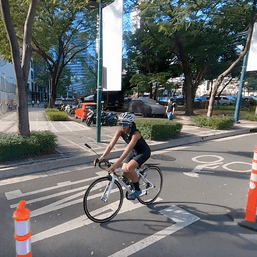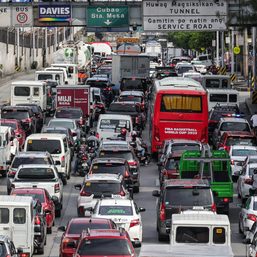SUMMARY
This is AI generated summarization, which may have errors. For context, always refer to the full article.

MANILA, Philippines – The Metro Manila Council (MMC), through the Metropolitan Manila Development Authority (MMDA), approved a resolution banning certain e-vehicles from traversing major roads in the National Capital Region (NCR).
MMDA Regulation No. 24-022 prohibits e-bikes, e-trikes, tricycles, pedicabs, pushcasts, and kuligligs from traveling on national roads, circumferential roads, and radial roads in all cities of NCR starting April 2024.
Here is the list of roads where these vehicles are banned:
- C1: Recto Avenue
- C2: Pres. Quirino Avenue
- C3: Araneta Avenue
- C4: EDSA
- C5: Katipunan/CP Garcia
- C6: Southeast Metro Manila Expressway
- R1: Roxas Boulevard
- R2: Taft Avenue
- R3: Osmeña Highway
- R4: Shaw Boulevard
- R5: Ortigas Avenue
- R6: Magsaysay Blvd./Aurora Blvd.
- R7: Quezon Ave./Commonwealth Ave.
- R8: A. Bonifacio Ave.
- R9: Rizal Ave.
- R10: Del Pan/Marcos Highway/McArthur Highway
- Elliptical Road
- Mindanao Avenue
- Marcos Highway
- Boni Avenue (Mandaluyong)
- España Blvd.
Those caught violating the ban will face fines of up to P2,500. Motorists driving “electric-powered motor vehicles and tricycles” will also be required to have a driver’s license. Those apprehended without a license will have their vehicles impounded.
“Due to the proliferation of e-vehicles, the MMC deemed it imperative to regulate and penalize those who will traverse the national roads using such means of transportation,” MMDA Acting Chairman Don Artes said in a press conference on Wednesday, February 28.
Each local government unit within Metro Manila may also issue their own ordinances for secondary and other inner roads in their area.
Previously, the MMDA admitted that it lacked unified guidelines regarding the use of e-trikes and e-bikes. Before the MMDA resolution, the most commonly cited regulation for e-vehicles was an administrative order by the Land Transportation Office that categorized electric vehicles and outlined where they could travel based on their maximum speed.
Is a ban necessary?
Artes said that this was not a total ban on e-vehicles. Instead, the resolution is meant to set clearer guidelines around e-bikes and e-trikes, which were “a common cause of traffic and road crash incidents.”
There were 554 road crash incidents involving electric vehicles in 2023, according to MMDA’s data.
However, the Move as One Coalition (MAOC) has questioned the move by the Metro Manila Council to ban the light e-vehicles on the basis of safety risks, saying “MMDA’s sweeping statement lacks context.”
MAOC pointed out that based on MMDA’s 2022 data, fatalities from bike, e-bike, and pedicab accidents only accounted for 33 of the 681 total fatalities, or 4.84%. Bikes, e-bikes, and pedicabs also only accounted for a similarly low 5.88% of total non-fatal injuries and 2.05% of total road crashes.
“For added context, MMDA should release the 2023 data on road crashes involving cars and the number of fatalities and non-fatal injuries. Cars have consistently accounted for the highest percentage of vehicles involved in a road crash since the [Metro Manila Accident Reporting and Analysis System] began in 2005,” MAOC said in a statement. – Rappler.com
Add a comment
How does this make you feel?


![[Rappler’s Best] Where the streets have no name](https://www.rappler.com/tachyon/2024/03/2-1.jpg?resize=257%2C257&crop=307px%2C0px%2C720px%2C720px)


![[DOCUMENTARY] Biking 120 kilometers in Metro Manila](https://www.rappler.com/tachyon/2024/03/bike-commute-metro-manila-documentary-carousel-scaled.jpg?resize=257%2C257&crop=216px%2C0px%2C1440px%2C1440px)




There are no comments yet. Add your comment to start the conversation.